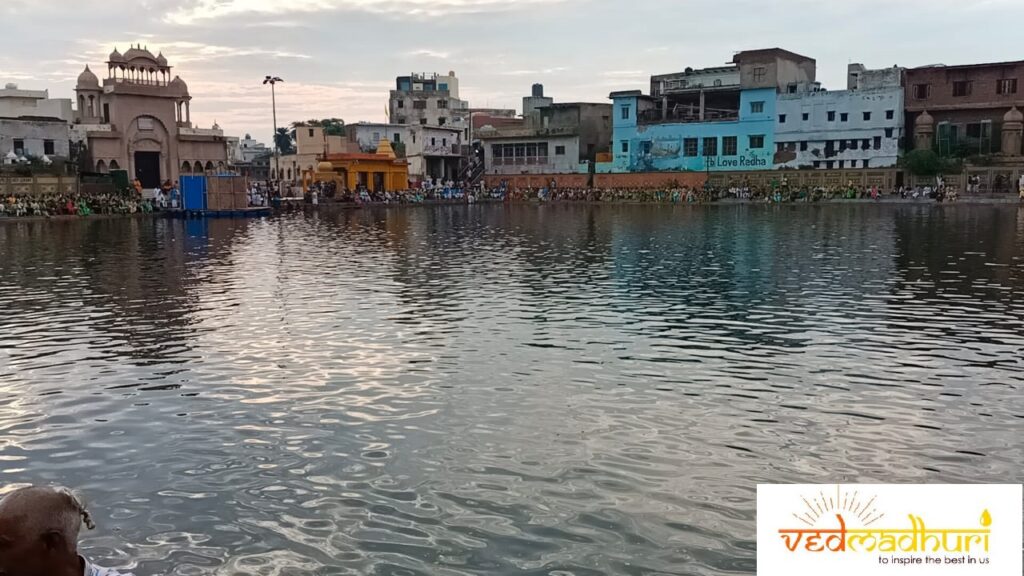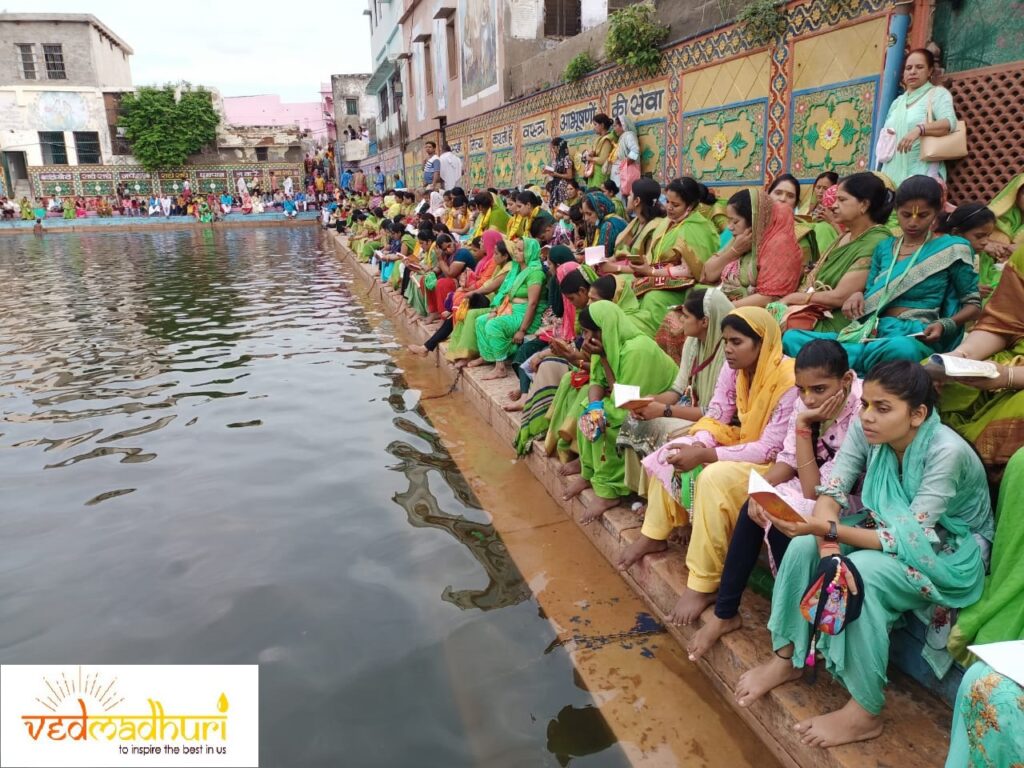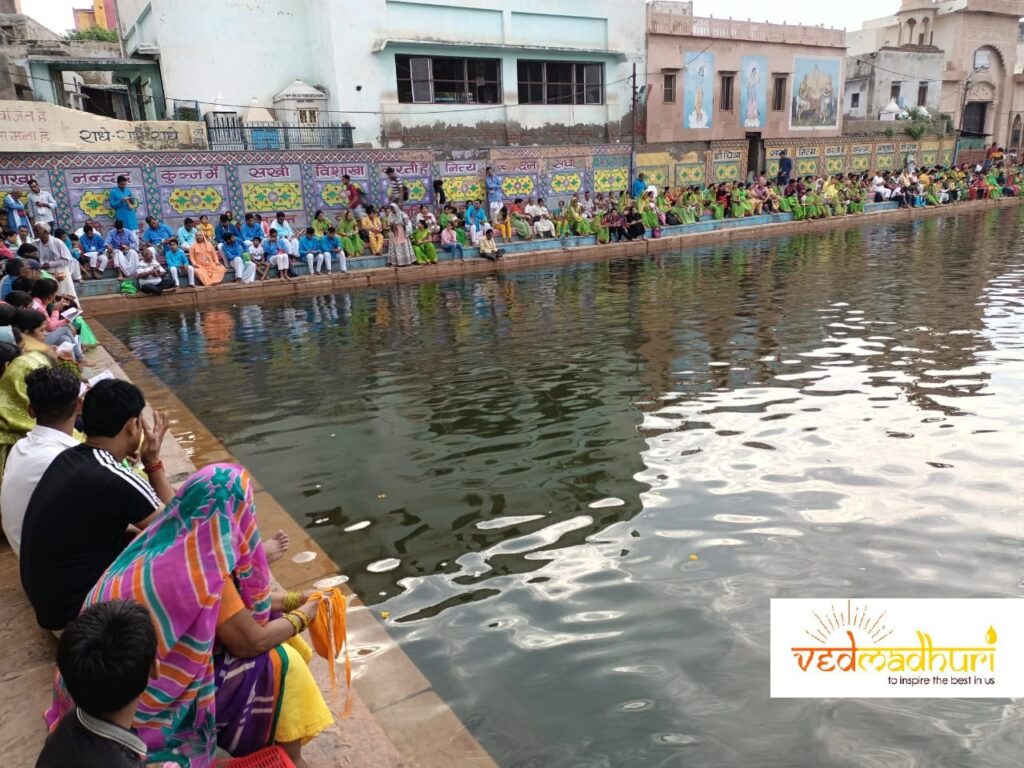
Abstract: Radha Kunda and Krishna Kunda are two natural water reservoirs, amongst one thousand such water bodies, located in the holy region of Braja. The two ponds are held sacred in the Vaishnava tradition, especially in the tradition of the Gaudiya sect. An age-old saga about the excavation of these ponds by Radha and Krishna as an act of repentance for accidental cow slaughter is quite interesting. The narrative is relevant even today as it goes on to settle the role of Dharma in handling ‘victimless crimes’ and ‘ecological sustainability.’
Radha Kunda (राधा कुण्ड) and Krishna Kunda (कृष्ण कुण्ड) are two sacred water reservoirs located in village Arit (आरिट) in Mathura, about 3 Miles North-East to the foot of the legendary Govardhana hill (गोवर्द्धन गिरिराज) that Shri Krishna lifted and held upon little finger of his left hand to protect his peoples from untimely devastating rains and thunderstorm. Arit is the legendary place where he had slain demon Arishtasura (अरिष्टासुर) who had deceitfully taken the form of a bull in a secret plot to murder Shri Krishna.
The legend goes on to say that Shri Radhika, eternal consort of Shri Krishna, refused to let him even touch her since he had killed a bull, albeit a fake one. Shri Krishna, who had grown up among cattle and cowherds, accidentally committed the grave sin of cow slaughter. The sin was bitter, Radha will not be sweet. Krishna appealed to Radha for mercy reminding her of their relationship of unfailing love. Krishna sought repentance, asking Radha to tell exactly how he would be cleansed of the sin. Krishna’s act was not merely an individual transgression, but a sin against the community of cowherds. What Radha desired was the mark of true repentance: a heart that is truly contrite and a service to their community, who venerated cow as representative of divine and natural beneficence. How could Krishna, the saviour, set a wrong example before his people ? Radha asked him to build a new water reservoir, fill it up with water from all the tirthas (तीर्थ=sacred places) and take a dip in it to come out clean. Krishna worked very hard, day and night, and finally succeeding in digging a large pond with his heels, in which he invoked all the tirthas and the pond came to be known as Krishna-kunda. Radha, the merciful also dug another reservoir in the vicinity of Krishna Kunda with her bracelet. It is told that thereafter it was Krishana’s turn, who instructed all the tirthas to go on a strike since Radha had not considered his innocence in the episode of accidental killing of a fabricated bull. So Radha’s reservoir remained dry until she built a mental resolve that she will fetch water from Manasi Ganga (मानसी गंगा), a little far in the Govardhana hills, to fulfil her commitment. Her steely resolve changed the situation and water from Krishna Kunda percolated to fill up Radha Kunda as well!
This happened on the eighth of the dark half of Kartika month (October-November) which is celebrated as ‘Bahulashtami’ (बहुला अष्टमी) in the Vaishnava tradition of Braja’- the day of appearance of Krishna Kunda and Radhe Kunda. Ved-Madhuri retold this storyon the day of Radhashtami (राधा अष्टमी) which is being celebrated today, on the eighth of the bright half of Bhadrapada (August-September) to commemorate the birth of all merciful Radha. The story of Krishna Kunda and Radha Kunda finds a prominent place is the Gaudiya tradition, besides their glorification in Padma Parana, which says यथा राधा प्रिया विष्णोः तस्याः कुण्डं प्रियं तथा । सर्व गोपीषु संवैका विष्णोः अत्यन्त वल्लभा ।। That means, “Like Radha is dear to Vishnu (that is, Krishna) among all the milkmaids being his beloved; so is her cherished Radha Kunda dear to him”.
This legend is timeless, like the eternal love of Radha and Krishna. Gaudiya tradition offers some historical insight into the “ discovery of the two lost ponds” by Chaitanya Maha Prabhu (1486-1534) who went into a trance after visiting the “ Kali-Khet” and “ Gauri-Khet”- the black field and the white field; representing before him as the embodiment of Krishna and Radha. Raghunatha Das Goswami (1494-1571), who served Mahaprabhyu in Puri for Sixteen years, settled at this place. He is credited to have revamped the two water-logged fields into their original form during the reign of Akbar, whose royal troops had quenched their thirst from their water. Krishna Kunda came up as a skewed pond from the “Kali Khet” and Radha Kunda appeared as a perfect rectangular pond from the “Gauri Khet”. Two Kundas are located very close to Radha Kunda, namely Jagmohana Kunda (जगमोहन कुण्ड) and Malyaharini Kunda (माल्यहारिणी कुण्ड). These Kundas or natural water bodies along with their ghats (घाट=steps for reaching the water level) are chronicled by the British administrators in their memoirs of Mathura District.
The Goswamis found this area of Braja congenial for practicing spirituality and their ‘baithaka’(बैठक seats), “vasa” (वासा living Chambers), “Kutis” (कुटी meditation cottages) and “Rasa Mandala Vedis”(रासमंडल वेदी platforms for performing rasa, the divine dance), besides their Samadhis (समाधि last rite monuments), are located all around the two Kundas. One can visit all these spots, which is a private property of Gaudiya Matha, during Braj Parikrama (ब्रज परिक्रमा the traditional foot-journey in a clockwise direction). The ghats of the two Kundas are illuminated on the night of Bahulashtami. Tortoises, typically found in the Yamuna waters, also thrive in these Kundas. People visit the Kundas and meditate upon the all merciful Shri Radha on the day of Radhashtami.
The story of appearance of Radha Kunda and Krishna Kunda is profoundly inspiring. It goes on to settle two very pertinent issues regarding the ethics and ecology. Firstly, the ethical issue of cow slaughter. The cow is sacred to Indians for countless centuries because it has been the basic source of life for them. The Sanatana Vedic Dharma prohibits killing them or eating beef. (Just like eating a dog, cat, or a horse is frowned upon in the West because of their love and respect for the loyalty of these animals!) Upholding the core values of Dharma is important not only for the individual, but also in the larger interests of the society. Krishna killed Arishtasura, who was in the form of a bull. Killing a demon was undoubtedly a heroic deed, however, Krishna was penalized by Radha, her Goddess, for cow slaughter. The storyteller did not decriminalize his act even though Krishna was an incarnation of God. The moral of the story is that the real repentance for such sins, like cow slaughter, which the modern jurist would term as ‘Victimless Crimes’, is by compensating the community whose vital interests have been hurt; and, not by inflicting corporal punishment to the perpetrator.
The issue of ecological sustainability comes next. Radha and Krishna offered two fresh water bodies to their community living in the sacred region of Braja. Climate change and rapid urbanization in Mathura-Agra axis since the time of king Kanishka to Mughal Emperor Akbar turned the legendary evergreen forests of Braja into scrub forests and the silted Kundas turned into eutrophic vegetation. The Goswamis restored the lost sources of fresh water that proved a great boon for the community living in an arid landscape. The word “Tirtha” used for pilgrimage sites, actually means the spot at the banks (तीर=tira) of a water body. Most of our ancient Indian temples and tirthas are located close to such water bodies. It is high time we undertake restoration of the water bodies in our tirthas and revisit the legal framework which does not sanction any private individual or agency to undertake the restoration of water bodies. The Sanatana Vedic Dharma believes in the presence of God, not only in temples, but our gods continue to be present in the hills, rivers, water bodies, groves, everywhere. Let us draw some inspiration from the saga of Radha Kunda and Krishna Kunda.
Ved-Madhuri joins the faithful who visited Radha Kunda today:


